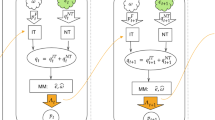Abstract
Recent agent-based models have demonstrated that agents’ herding behavior causes volatility clustering in stock markets. We examine economies where agents herd on others, yet they have limited sets of information on other agents to imitate. In particular, we conduct experiments on economies with agents with different levels of information sharing where agents can imitate: (1) the strategies of others but with an error, (2) the strategies of only a fraction of agents, or (3) the strategies of others, but update their parameters only by a proportion. In each experiment we change the likelihood that agents make errors to copy the strategy of others, the fraction of agents to herd, or the proportion of the parameter that agents update, in order to examine the effect of the different degrees of information sharing on volatility clustering. We show that volatility clustering tends to disappear when agents have limited information on the strategies of others, and agents need to imitate the strategy details of others in order to generate the clustered volatility.
Similar content being viewed by others
References
Apesteguia J, Huck S, Oechssler J (2007) Imitation—theory and experimental evidence. J Econ Theor 136: 217–235
Arthur B, Holland J, LeBaron B, Palmer R, Tayler P (1997) Asset pricing under endogenous expectations in an artificial stock market. In: Arthur WB, Steven ND, David A (eds) The economy as an evolving complex system II. Addison-Wesley, Reading, pp 15–44
Bornholdt S (2001) Expectation bubbles in a spin model of markets: intermittency from frustration across scales. Int J Mod Phys C 12: 667–674
Brenner T (2006) Agent learning representation: advice on modelling economic learning. In: Tesfatsion L, Judd KL (eds) Handbook of computational economics, vol 2: agent-based computational economics. North-Holland, Amsterdam, pp 895–947
Brock W, Hommes C (1998) Heterogeneous beliefs and routes to chaos in a simple asset pricing model. J Econ Dyn Control 22: 1235–1274
Brock W, Hommes C, Wagener F (2005) Evolutionary dynamics in markets with many trader types. J Math Econ 41: 7–42
Chen S, Yeh C (2001) Evolving traders and the business school with genetic programming: a new architecture of the agent-based artificial stock market. J Econ Dyn Control 25: 363–394
Comerton-Forde C, Rydge J (2006) The current state of Asia-Pacific stock exchanges: a critical review of market design. Pacific-Basin Finan J 14: 1–32
Chowdhury D, Stauffer D (1999) A generalized spin model of financial markets. Eur Phys J B 8: 477–482
DeLong JB, Shleifer A, Summers LH, Waldmann RJ (1990) Noise trader risk in financial markets. J Polit Econ 98: 703–738
DeLong JB, Shleifer A, Summers LH, Waldmann RJ (1990) Positive feedback investment strategies and destabilizing rational speculation. J Finan 45: 379–395
Engle R (1982) Autoregressive conditional heteroscedasticity with estimates of the variance of United Kingdom inflation. Econometrica 50: 987–1008
Grossman S, Stiglitz J (1980) On the impossibility of informationally efficient markets. Am Econ Rev 70: 393–408
Gaunersdorfer A, Hommes C (2005) A nonlinear structural model for volatility clustering. In: Teyssiere G, Kirman A (eds) Long memory in economics. Springer, Berlin, pp 265–288
Kahneman D, Tversky A (1973) On the psychology of prediction. Psychol Rev 80: 237–251
Kaizoji T, Bornholdt S, Fujiwara Y (2002) Dynamics of price and trading volume in a spin model of stock markets with heterogeneous agents. Physica A 316: 441–452
Kirman A (1991) Epidemics of opinion and speculative bubbles in financial markets. In: Taylor M (ed) Money and financial markets. Macmillan
Kirman A, Teyssière G (2002) Microeconomic models for long memory in the volatility of financial time series. Stud Nonlinear Dyn Econometrics 5(4): 281–302
LeBaron B (2001) Evolution and time horizons in an agent based stock market. Macroecon Dyn 5(2): 225–254
LeBaron B (2006) Agent-based computational finance. In: Tesfatsion L, Judd KL (eds) Handbook of computational economics, vol 2: agent-based computational economics. North-Holland, Amsterdam, pp 1187–1234
LeBaron B, Arthur B, Palmer R (1999) Time series properties of an artificial stock market. J Econ Dyn Control 23: 1487–1516
LeBaron B, Yamamoto R (2007) Long-memory in an order-driven market. Physica A 383: 85–89
LeBaron B, Yamamoto R (2008) The impact of imitation on long-memory in an order-driven market. East Econ J 34: 504–517
Lui Y, Mole D (1998) The use of fundamental and technical analysis by foreign exchange dealers: Hong Kong evidence. J Int Money Finan 17: 535–545
Lux T (1998) The socio-economic dynamics of speculative markets: interacting agents, chaos, and the fat tails of return distribution. J Econ Behav Organ 33: 143–165
Lux T, Marchesi M (1999) Scaling and criticality in a stochastic multi-agent model of a financial market. Nature 397: 498–500
Lux T (2009) Rational forecasts or social opinion dynamics? Identification of interaction effects in a business climate survey. J Econ Behav Organ 72: 638–655
Menkhoff L, Taylor M (2007) The obstinate passion of foreign exchange professionals: technical analysis. J Econ Lit 45: 936–972
Mitchell M (1996) An introduction to genetic algorithms. MIT press, Cambridge
Muhlenbein H, Schlierkamp-Voosen D (1993) Predictive Models for the Breeder Genetic Algorithm. Evol Comput 1(1): 25–49
Offerman T, Sonnemans J (1998) Learning by experience and learning by imitating successful others. J Econ Behav Organ 34: 559–575
Pagan A (1996) The Econometrics of Financial Markets. J Emp Finan 3: 15–102
Pingle M, Day R (1996) Modes of economizing behavior: Experimental evidence. J Econ Behav Organ 29: 191–209
Routledge B (1999) Adaptive learning in financial markets. Rev Finan Stud 12: 1165–1202
Shiller R (2001) Exuberant reporting. Harv Int Rev 23(1): 60–65
Simon H (1979) Rational decision making in business organizations. Am Econ Rev 69: 493–513
Vriend N (2000) An Illustration of the Essential Difference Between Individual and Social Learning, and its Consequences for Computational Analysis. J Econ Dyn Cont 24: 1–19
Yamamoto R, LeBaron B (2010) Order-splitting and long-memory in an order-driven market. Eur Phys J B 73: 51–57
Author information
Authors and Affiliations
Corresponding author
Rights and permissions
About this article
Cite this article
Yamamoto, R. Volatility clustering and herding agents: does it matter what they observe?. J Econ Interact Coord 6, 41–59 (2011). https://doi.org/10.1007/s11403-010-0075-5
Received:
Accepted:
Published:
Issue Date:
DOI: https://doi.org/10.1007/s11403-010-0075-5




